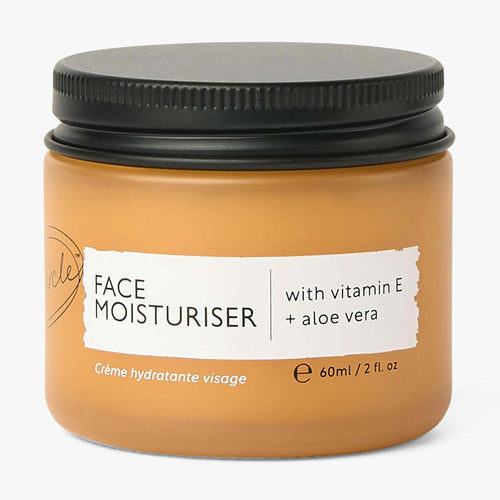If you have melasma, you’re probably experiencing pigmentation or blotchy dark brown or grey patches or spots on your skin. While melasma is harmless and isn’t a sign of anything more sinister, it can cause body confidence issues.
We understand that it can leave you feeling self-conscious and even exposed. So if you’re struggling with this common skin condition or just want to learn more, then read on for our UpCircle guide to melasma which explains the causes of melasma in more detail and how you can manage it.
What is melasma?
Melasma is a skin pigmentation condition, which typically affects women between the ages of 20 and 40 and is more common in those with tanned or darker complexions. It is characterised by dark blotches or spots on the skin, particularly the face. While melasma causes discolouration, it is not painful, itchy, or uncomfortable in any way.
Also known as chloasma, the skin condition melasma can affect all areas of the face and body, but typically appears on the forehead, nose, upper lip, and cheeks. Melasma affects both men and women. However, it is more widespread in females, with up to 33% of women routinely experiencing melasma during their reproductive years.
What are the causes of melasma?
There are many reasons why melasma can occur and the triggers may differ from one person to another. These are some of the most common causes:
Sun exposure
The reason we get a tan in the sunshine is due to the sun’s rays creating more brown pigment in our skin. Exposure to the sun (or use of sunbeds) can cause melasma or bring on an outbreak of dark spots. However, it is unlikely that melasma is just caused by sun exposure in the way that sunspots are.
Birth control pills
Some oral contraceptives, patches and IUDs contain oestrogen and progesterone hormones, which are associated with melasma. Indeed, it is thought that hormonal changes are a primary driver of melasma in most cases. If you believe your melasma is exacerbated by hormonal birth control, speak with your doctor to discuss non-hormonal alternatives.
Genetics
You are more likely to develop melasma if there is a history of the skin condition running in the family. It is also more common in darker skinned individuals and this is evident within families.
Pregnancy
Up to 50% of women will face melasma issues during pregnancy as the body produces more oestrogen which can trigger the condition, again showing the hormonal connection. Also known as ‘the mask of pregnancy’, melasma is a cosmetic skin concern, so there is no risk to the baby – and it is not a sign of complications in pregnancy. Unfortunately, it is just one of the non-blooming symptoms of pregnancy that some people experience!
Is melasma permanent?
Melasma is a chronic skin condition and can be long-lasting. Some women only experience it whilst pregnant, and others may go through periods of flare-ups and remission.
Melasma treatments
While there is no cure for melasma, there are lots of things you can do to minimise the appearance of dark spots on your skin:
Stay safe in the sun
Always wear sun protection – even on overcast days. It’s advisable to choose an SPF of at least 15 to minimise the risk of a melasma flare-up. We’re launching our own UpCircle SPF very soon, so stay tuned!
Melasma is not just restricted to the face. It can affect any part of the body exposed to UV rays. Stay out of the summer sun where possible.
Avoid tanning beds
Tanning beds should be avoided for many reasons, but if you have melasma you should definitely avoid them. Sunbeds stimulate melanin and expose the face and body to harmful ultraviolet radiation. If you want golden, glowing skin this summer, opt for a self-tanning cream or spray tan instead of hitting the tanning salon. Alternatively, we urge you to embrace the wonderful skin tone you have – it’s what makes you unique!.
Adopt a melasma-busting skincare routine
Establishing a skincare routine that is designed to combat the appearance of melasma is one of the most effective ways to reduce pigmentation and stop further brown spots from developing.
Here’s our recommended skincare regime for melasma-prone skin:
Exfoliate regularly: Using an exfoliant that is rich in Vitamin E helps to reduce the signs of melasma. Our Floral Blend Coffee Face Scrub contains Vitamin E and Vitamin B, which also helps to lighten dark spots on the face. Exfoliating removes dead skin and encourages cell regeneration, which can hasten the time in which melasma fades.Apply a weekly kaolin clay mask: Kaolin clay is rich in minerals and can help to resolve melasma skin problems. Gentle enough for all skin types, the clay also absorbs excess sebum to prevent acne breakouts. Our Kaolin Clay Face Mask will leave your skin feeling balanced and refreshed while helping to reduce the effects of melasma.
Living with melasma
Melasma can be frustrating to treat and can often reappear after a period of remission – especially after exposure to the summer sun. Improving melasma is possible with a combination of sun protection and the right skincare routine.
By following our melasma skincare tips, you can reduce the appearance of dark patches on your face and speed up the time it takes for melasma to fade. Regularly using topical skincare products is your best defence in treating melasma – take our skin quiz to discover the best products for your skin type.






